When people find out that I deal with swimming pools on a daily basis, one of the most common questions I get is, “What do you think about salt pools?” to which I find myself going into a little sales blurb on what a salt pool is. I would say 90% of the people have heard of salt pools, but don’t really know how they work. Most know they are supposed to be nicer than chlorine pools and think that salt pools don’t use chlorine, but this is not the case. This article will explain how a pool salt system works, if one is the right choice for you and then the process of converting your pool from traditional chlorine to salt.
What is a salt water pool?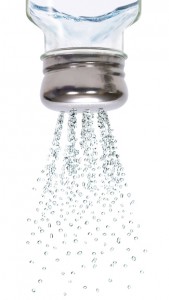
With a salt pool, you add salt to your pool water. This amount is below the taste threshold meaning you don’t taste a strong salt taste like associated with the ocean. Ocean water is at 50,000 parts per million (PPM) of salt. A salt pool is a mere fraction of this and only has 3,000 PPM of salt. In a salt pool an electrode (also called a salt cell) is installed in your plumbing and as the diluted salt water passes through the cell, the electrical reaction between the electrode and the salt water creates chlorine. So, with a salt pool you are still using chlorine to sanitize your pool as you are just manufacturing your own. The chlorine that is produced by a salt pool is a higher quality of chlorine that does not have the negative effects of traditional chlorine like the chlorine smell, red eyes and itchy skin. With a salt pool you no longer need to purchase chlorine tablets, liquid chlorine or shock as the salt system will be creating all of your chlorine. Salt systems also have a superchlorination feature that acts as shocking your pool. If you’re interested in learning more about salt water pools then I would suggest reading our recent blog post on “What is a Salt Water Pool” which goes into much greater detail on this topic.
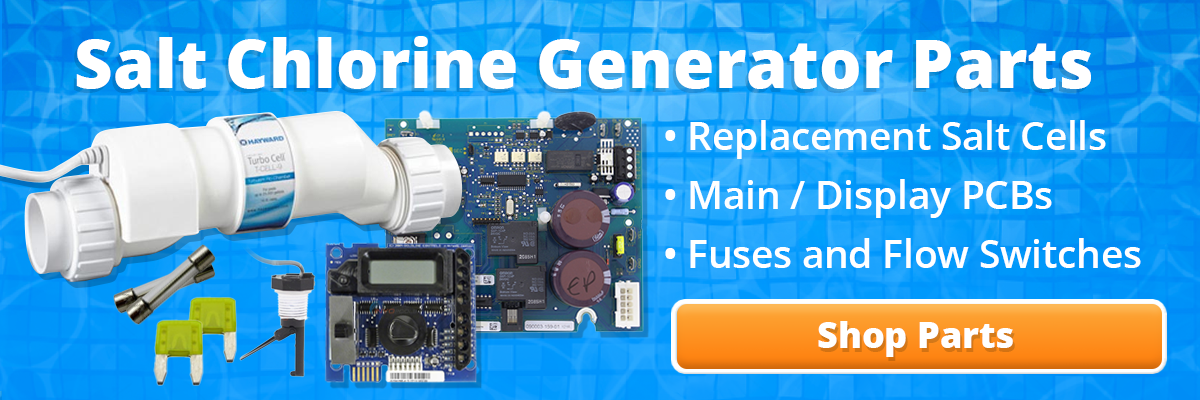
The pros & cons of salt pools
Pros:
- No more buying chlorine – A salt system manufactures natural chlorine. That means no more buying chlorine tablets, shock or liquid chlorine!
- No more manually adding chlorine – On a salt system you dial in your chlorine production and that is it. This is a major benefit over traditional chlorine where you have to make sure to add your chlorine to the pool each week and if you forget or go on vacation then you are faced with issues. I have to admit this is my favorite benefit of a salt pool.
- No chlorine smell, red eyes or itchy skin – The negative effects of chlorine like the chlorine smell, red eyes and itchy skin are all due to chloramines. The chlorine that is produced by a salt pool does not have chloramines. This means all of these traditional side effects of chlorine are eliminated. This is the reason why many people who swim in a salt pool think that it is a non-chlorine pool.
Cons:
- High pH & calcium build-up – In salt pools the pH level of the water likes to rise. If you don’t keep your pH levels in check then this can lead to calcium scaling in your pool or your salt cell. This is easily maintained by testing your pH levels weekly and adding muriatic acid if you need to lower your pH.
- Salt cell replacement – Every 3-7 years you will need to replace your salt cell which costs between $200 – $700.
- More parts – On a salt system there are more parts which can become faulty like the circuit board, salt cell, flow sensor or flow switch.
- Corrosive to pool and equipment? – This topic is open for debate as many pool professionals feel salt water is perfectly fine for your equipment and others feel you need special equipment. Our experience is that sometimes the shaft seal on your pool pump may fail a little quicker, but this is an easy inexpensive fix. If you are adding a heater to your pool you may consider a cupro nickel heater as this heater has a heavy duty heat exchanger which is supposed to hold up better to salt. The last item you may consider is a sacrificial zinc anode. You place this zinc disk in your skimmer and the anode absorbs all the corrosion
Converting from chlorine to salt
Once you have made the decision that you want to convert from a traditional chlorine pool to a salt pool then your first decision will be which salt system to choose. A few considerations you will want to take into account when selecting your salt system are listed below.
Selecting your salt system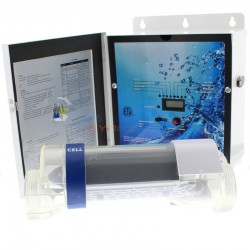
- Pool size: Salt systems range from pools 10,000 gallons – 100,000 gallons. You will need to select the system based on your pool size. You can always go with a larger unit on a smaller pool. This will allow you to run the salt system for shorter periods of time and you will have longer time between replacing your salt cell.
- Budget: Salt Systems can cost anything from $500 – $2,000. The less expensive models have few bells and whistles where the higher end systems have a bunch of fancy features including the ability to control all your pool equipment.
- Features: Salt systems vary in regards to the features offered. Some of these features include: salt readout, self cleaning, self diagnostics, digital readout and the ability to control pool equipment.
- Replacement cell cost: This is an important factor and is often overlooked. Your salt cell will need to be replaced every 3-5 years. Replacement salt cells range from $200 – $700. So, if you get a salt system which uses a $200 cell then you could replace this cell 3½ times before it costs as much as replacing the $700 cell.
- Where to buy: Here you can check out our full line Salt Chlorine Generators we even have a model for in-ground pools starting at $499.

Installation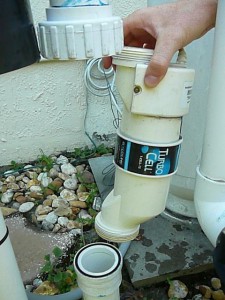
Now it is time to decide if you are going to hire a pool company to install the salt system or do it yourself. If you go the pool company route, then you are looking at $300 – $500 for installation. Many homeowners decide to tackle this DIY project themselves as this is usually a 3-6 hour job that can be tackled over the weekend. We have put together a step-by-step video on “How to Install a Salt Chlorine Generator” which would be a good primer to see if you think you can tackle the job. The installation consists of some basic plumbing and electrical work.
Adding the salt
After you have installed your salt system the next step is to add the salt to your pool. We have put together a guide on “How to Add Salt to a Pool“ which discusses this process in greater detail, but we will touch on the basics which are:
- How much salt do you need?
- Testing water
- Selecting salt
- Adding salt
The first thing you will want to do is check the owner’s manual to determine how much salt you will need. Normally this will be between 400 lbs. – 1,000 lbs. based on the size of your pool. You will want to pick up some pool salt test strips as you don’t want to assume that you are starting at 0 PPM of salt as often your water will have some salt in it (for example you may be starting off at 200 PPM of salt). The salt strip will also be used after you add all of your salt to ensure you are within the 3,000 – 3,5000 PPM salt range.
Next you will need to pick up some pool salt. This can be easily found at your local home improvement store, pool store or even grocery store. You will just want to make sure the salt you choose is at least 99.8% NaCl and that it is granular (no pellets or rock salt). Often people get concerned when they hear that they need to add 400 lbs. of salt, but this is just 10 bags of salt (40 lb. bags) and salt costs about $5 per bag so this would be about $50 in salt. Salt does not dissolve from water meaning that you will only need to add additional salt if you experience evaporation, heavy rain, water being splashed out of the pool or a leak. Normally you would add several bags of salt throughout the year to maintain the required salt levels.
Now it is time to add the salt to your pool. Your pool pump should be turned on and the salt system should be turned off. You will want to broadcast the salt evenly around the pool for even distribution. Avoid adding the salt directly to the skimmer or main drains at the bottom of the pool as this can damage your equipment. You will run your filter pump for 24 hours to allow for the salt to mix evenly through your pool water. After 24 hours use your salt test strip to verify that you have the correct salt reading of 3,000 – 3,500 PPM of salt.
Starting up the salt chlorine generator
It is very important to start off with good pool water. Your water chemistry should start off at the following values:
Salt: 3,000 – 3,500 PPM
Free Chlorine: 1.0 – 3.0 PPM
pH: 7.2 – 7.8
Cyanuric Acid (Stabilizer): 50 – 75 PPM
Total Alkalinity: 80 – 120 PPM
Calcium Hardness: 150 – 400 PPM
At start up it is best to shock your pool from an outside source like a standard granular pool shock. Then, wait until the chlorine level has returned to between 1 to 3 PPM before turning on the salt system. Now it’s time to kick on your salt system. We suggest setting the system to 50% chlorine production and let the system run for 24 hours. After 24 hours test your pool water with a good test strip to see if your free chlorine is between 1-3 PPM. If your chlorine is too high or too low, dial your chlorine product up or down in 10% increments and retest your chlorine in 24 hours. Repeat this process until the proper chlorine level is reached. The nice thing is that once the salt system is dialed in it is pretty much a set-it-and-forget system, because it is always there producing natural chlorine for your pool at the desired amount to keep your pool crystal clear. Salt systems also have a superchlorinate feature which shocks your pool. So if you ever run into demanding water conditions then this feature comes in handy to shock your pool and get your pool water looking clear again.

Maintenance
Testing your water
Now that you have your salt system up and running you will want to periodically test your water to make sure that your water chemistry is in balance with the values listed earlier in this article.
Prolonging the life of your salt cell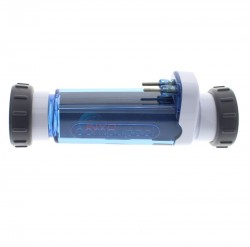
Salt cells normally last 3-7 years. To get longer life out of your cell, you will want to follow certain steps.
As your salt cell is in use, calcium deposits will build up on the blades of your salt cell. To remove this calcium build up, soak your cell in diluted acid solution. To prolong the life of your cell, you will want to clean it at least once a season. On the flip side you want to make sure you do not clean your cell too often or with too highly concentrated acid solution as this can strip the cell of its titanium coating making it useless.
Calcium build-up
Salt pools tend to make the pH in your pool want to rise so it is important that you are monitoring your pH levels and adding muriatic acid to reduce the pH. High pH levels cause much quicker calcium build up on your salt cell as well as on your pool tiles. I learned this the hard way! If you want to get fancy, many pool owners are coupling their salt systems with an acid feed pump. This is nice as the production of chlorine in your pool is automatically produced by the salt chlorine generator and the pH levels are automated by the feed of acid from the acid pump.
Need help converting your pool to saltwater?
When I built my pool I installed a salt system and I can honestly say it is one of my favorite features of my pool. After the initial set up, I really did not had to worry about my chlorine at all. If you have decided that you want to convert your pool from traditional chlorine to salt then post any questions in the comments below and we would be happy to help. Also if you have already made the switch, we would love to hear about your experience. You can also always reach us by phone at 1-877-372-6038 with any questions.

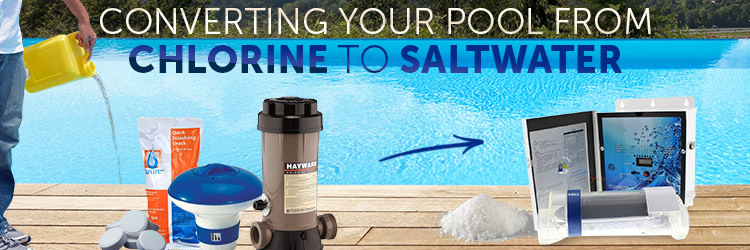

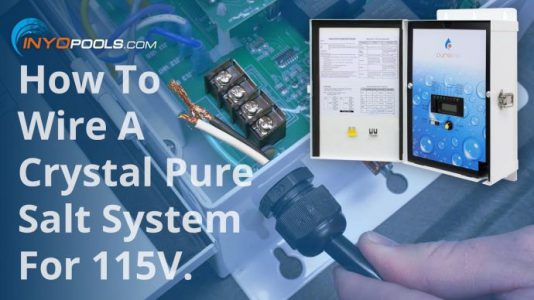
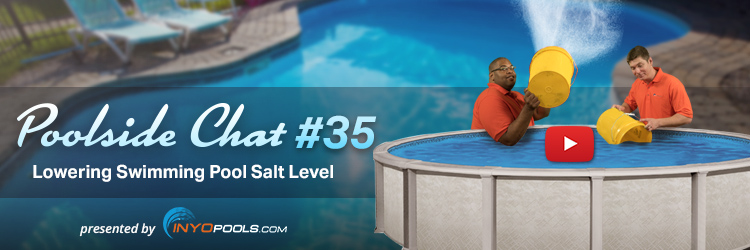
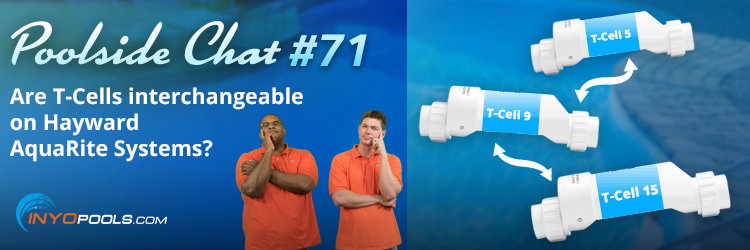







I have a Sta-Rite 196250 motor with my PHK2RA6F pool pump. When I replace my motor, is there a special seal kit for salt water? If I am to switch, what is the kit I should use and what is the difference between a chlorine kit and a salt kit?
Thanks
The main seal you need to replace is the shaft seal. For your Sta-Rite Super Max pump, the salt water shaft seal is the part number PS-3687. Unfortunately, the Super Max does not have a gasket kit package available for it, but you can check your seals for appearing dry, warped or cracked. The main difference between a chlorine and saltwater kit is the shaft seal.
Hi, I have an in-ground 35,000 gallon pool. We are in the process of having the liner replaced so thought this might be a good time to convert to salt water. We have a Hayward sand filter. I’m trying to figure out what all we need to purchase so we can weigh our options. So far, I’m thinking we need a salt water generator, salt cell, zinc anode, & salt water test strips. Am I missing anything??
I was looking a SAS generator but then I realized it only goes up to 30,000 gallons. The pool company that’s installing the liner said they have an Aqua-Rite system. Any suggestions?
Thank you!
Hayward Aquarite and Pentair Intellichlor systems are good models by the big name brands. We also suggest the Pureline Crystal Pure 40K.
You may have to get sealant for your pool deck; something like Natural Stone & Salt Water Resistant Sealer
Can I convert to salt with an inground vinyl liner?
Yes, you can. The process is the same as the method Patrick outlines in the article.
Hello! 🙂 I’m about to get a new pool liner installed and have been contemplating converting to a salt system. A couple questions. 1) is it less harsh on the liners longevity? 2) what is the average cost to get it set up for a 17,000 gal pool?
Thank you!
i have a 24′ above ground pool being installed, i want to know what is a good salt system to use. need to know everything i need to purchase for salt water pool. thank u
HI Sally P.,
We would suggest the PureLine Crystal Pure 20,000 Gallon Salt System PL7701 as a great salt system for a 24′ Round Above Ground Pool.
Thanks
Patrick
http://www.inyopools.com
Thanks for a great, thorough article. I’ve had a salt system since I first bought my pool 10 years ago. I had to replace the salt cell two years ago ($420), and the installer of the new one said the same as the article – he recommended a more powerful cell to be run at a lower rate, making the cell last longer. Friends just bought a house with an older pool and I’ve sung the praises of a salt system to them. I’m forwarding the article to them to help explain the whole thing. There’s nothing I don’t like about my salt system!
If we have a Pentair Superflo VS, can we control power to the Salt System? So that it turns on and off with the auto timer on the pump?
New to pools and Very confused. Im Buying a forclosed home. It Has a pool about 5000 gallOns. Not sure what model/ kind of pump/ system it has. Im just assuming it was chlorine also. To convert to salt I would need just the salt chlorination cell? Or I need some type of system to go along with the cell? Does this stuff replace any existing pool hardware or attaches to the current hardware? Is a 15000 system overkill? I know nothing about pools but I am somewhat handy, is this a job I can take on myself?
The4 first step would be to look at your pool system to figure out what is there. Secondly, a salt generator system requires the control box, the cell, and the flow switch (sometimes the flow is built into the cell.) The salt generator replaces any other sanitation hardware like a chlorinator, ozonator, or ultraviolet.
You want to oversize the cell because it allows the cell to work less, therefore making it last longer.
Thank you for the fast reply. Once we close on the home I will investigate and take pics of what’s there and be in touch. We can go from there. Thank you again,
“please go to the web sites we follow, like this one particular, as it represents our picks through the web”
I am so thankful I stumbled across this article. You rock!! Concise, detailed descriptions, quick responses. Thank you for the effort you have put into it.
I have an above ground pool 4′ x 16′ about 5000 gallons, my pump went out last year and we are wanting to convert to salt water this year. I have found the salt water generators, but is there a pump and generator combo or separate you would recommend? Thank you for the information on starting the pool, it has answered lots of questions we had
How does a salt system affect the type of finish of a pool? I’m interested to know if the salt cuts the life of a plastered pool faster than a pebbletec or pebblefina finish for example. I would like to convert my chlorine system to a saltwater but worry that the current plaster in the pool won’t hold up for long as I would hate to not just have to replace the salt cell but also have to re-plaster my pool more often.
Saltwater should only affect new plaster. This is why installers who have installed new plaster will wait 30-60 days before adding salt to the pool. Improper water chemistry is more likely to cause damage to plaster than the simple addition of salt.
Aloha again, is it necessary to maintain cyanuric acid levels within a certain range with a salt water pool?
Yes, you must maintain CYA levels in a pool, and especially in a saltwater pool. CYA protects your chlorine from being burned off by sunlight. Tablet and liquid chlorine come with CYA pre-mixed in the formula, the chlorine created by salt chlorine generators is pure chlorine with zero CYA. The only way to maintain your chlorine levels in safe proportions is to have proper levels of CYA.
Aloha, I’ve recently purchased a home with a 30,000 gallon gunite pool that is in dire need of resurfacing. I’ve read your comment about waiting 30 days after the resurfacing to add salt. Which chlorine generator would be best for my pool, and can the cell be mounted vertically, or must it be horizontal?
A couple generators that would do well on that pool size is the AquaRite 40K and the IntelliChlor IC40
Evening, just had a pool installed with a salt system, how long before I can switch over to salt from chlorine?
Thank you
Hi AJ, If your pool is a gunite pool you will want to wait 30 days after the interior finish is applied before you add salt or run your salt chlorine generator. The reason for this is that during the first 30 days of a new pool finish is when the plaster is still curing and the interior finish is most susceptible to scaling or staining. After 30 days you are all set to add salt and start up your salt chlorine generator.
Thank You
Patrick
Thank you
Great article. My pool has black porcelain around it. I am concerned with stains from the salt left behind from evaporated pool-water that swimmers drip on the floor around the pool and from wet feet-tracks around the house. Is the concentration enough to be a problem?
Awesome article. Is it required to drain the water once a year or not? If you install the Acid Pump, would that help with the calcium build up and prevent this?
No, it is not mandatory to drain your pool once a year. To prevent calcium buildup, use a descaling agent like Super Rust & Scale Remover (1 Qt) – NY180 or Natural Chemistry SCALE FREE 2L – 07511
Mathew
Our builder mistakenly installed our pool with the old chlorine system when we had purchased a salt water system. We were told, don’t worry its a simple correction. Are they right?
Yes, it is. Besides adding the salt, the builder will come out, cut out the chlorinator, and plumb in the salt cell and mount the control box. Total work time might take about an hour for that.
I have a 7 year old chlorine pool with all Pentaire equipment, Pentaire DE filter, and Pentair Mastertemp 400 heater, Pentarire VS-3050 pumps, etc.
Will converting to salt hurt the Master Temp heater?
it depends on which Mastertemp you own. The MasterTemp is available in either a standard Copper or heavy duty Cupro-Nickel heat exchanger, The cupronickel is the preferred heat exchanger for saltwater pools because copper will corrode much faster when used in saltwater. If you have the copper model you may be able to switch it out for the Cupro-nickel. Tube Sheet Coil Assy Kit 400 Hd After 1-12-09 (474065) or Tubesheet/coil Kit Copper-nickel 400 pre-2009 (77707-0244)
Hi Matthew,
I just parchase a new home with an L Shape chlorine pool. It was in really bad condition so i bad to get a new filter, pipes and next year I have to replace the lining as well. I had a difficult time keeping up with it so I was contemplating to change it to salt water. Your blog help me a lot and I decided to go for it. I am going to hire a company to do it but I wanted your guidance on the type of equipment I should get. My pool is in ground 40,000 gallons.
Joss – if your pool is at the 40K gallon mark, the best route would be the Pentair IntelliChlor IC60. most units only go up to about the 40K gallon range, but those models would need to work near 100 percent of the time to maintain chlorine levels. Always oversize salt chlorine generators.
Also to confirm you have a 40K pool can you use this pool volume calculator? Because your pool is an L-shape, break your pool into 2 rectangles.
Hi Matthew, excellent blog!
I just switched to a salt chlorination system (Hayward Salt and Swim Pro).
To test salt water PH and chlorine level can I use the same test kits as the one used for regular water?
Also, to adjust PH up or down can I use the PH Up or PH Down powders usually sold on megastores?
Thanks, Ronald. If you need to test chlorine, pH, and alkalinity levels just your standard test strips will do fine. If you want a more accurate reading of your water chemistry, I suggest using chemical reagent kits like the ones produced by TF Test Kits. To test salt levels you will need to make sure to buy a salt specific test kit.
Yes, you can use standard pH Up or Down to adjust the level in a saltwater pool.
How large salt water system to run 115000 gallon pool
A pool of that size would require a commercial salt chlorinator. Your best bet would be the AutoPilot Professional 4-Cell system (or higher). If you have high bather loads then you should look into the 5 or 6 cell unit.
I live in upstate New York and was thinking of converting to a salt pool next spring. I have a 25K gallon pool that has a baquacil sanitation system. I have been running baquacil for a lot of years and was wondering what it would involve to convert to salt? Would I have to empty out all the water to do this or is there a way to do it without having to empty all the water out? I have a sand filter with a 1hp pump. Thanks for any advice you can offer.
We have yet to cover this subject but with a quick search, I found a blogger who has: Tired of Bacquacil? Switch to a Salt Chlorinator!
I have a 20×40 inground pool with a vinyl liner. Thinking about converting to salt water in the spring. Live in Illinois. What size salt water cell will I need?
To play it safe I would go with one of the 40K gallon models like the Pentair Intellichlor IC40 or the Aquarite 40K.
Great resource for just about any question. We just bought house with an 8000 gallon in ground pool. With heater and salt system, but when vacant, it was maintained as a well-balanced chlorine pool. It uses an aquarite generator and the inspect cell light is on which according to a manual I found online means we might have to replace the cell. My question is, is the “inspect cell” light accurate with no salt in the water? Do I need to add salt then check again? Also, the manual talks about needing cyanuric acid as stabilizer. What’s the reason behind that?
If there is no salt in the pool then your cell may be thinking there is fault causing the control box to show an alert. Take a sample of your water for to get a free water test a local pool store then post the results. We need to get an accurate reading of your pool’s chemistry levels including its salinity to get an idea what needs to be done.
Cyanuric acid or water conditioner prevents your chlorine from being burned off by sunlight; essentially it is sunscreen for chlorine. Liquid and tab form chlorine has stabiliser built into the solution but the chlorine made by salt cells does not, making it necessary for it to be added to the water.
There is no salt in the pool. Had it tested. Everything was good. The salt was 0, alkalinity was a little high so I got some chemicals to lower it. The real question is will the salt cell diagnostic light saying “inspect cell” be accurate with 0 salt content? Is there a way to find out if my cell is bad without dumping my salt in the pool?
Ok, I think the real question is, why have a salt cell if you do not want to put salt in the pool? Of course, the cell is going to read an error if the thing that it requires the most is not present. Your pool is like a bland soup, just add salt.
Also, how are you sanitizing your pool?
We just moved into it and while vacant it was established as a chlorine pool. We have all the equipment for a saltwater pool, I just wanted to be sure the salt cell actually worked before dumping in the salt. Sounds like I won’t know until I dump the salt in.
Next issue is that we have outdated timers hooked up for pump and saltwater cell operation. Sounds like we might need to hire an electrician to come in and rewire them so that the cell shuts down when the pump does. Do you have any information concerning how to get those systems hooked up?